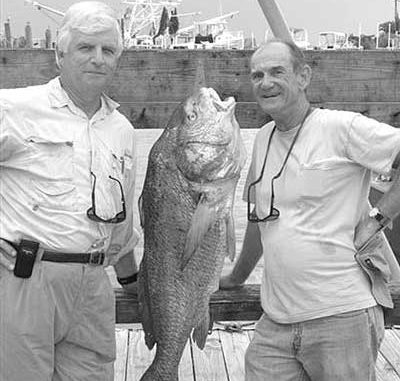
If locating transition trout has got you down, put your bay boat to use by fishing the wells and pipes — and the cobia that hold on them — this September.
As the red popped his body up out of the water, Master Jake’s jaw dropped. Normally calm and collective, and sure to cast on target to such a fish in an instant, this time he could only stare in awe.
“Dad, that fish was so big, his dorsal fin and tail were in different time zones!”
Although he was exaggerating a bit, this red was indeed huge, perhaps 25 pounds. Around some offshore rig, he might be considered just another peasant, but here in the deep marsh — some 30 miles from the Gulf of Mexico — he was indeed the “Spottail Elvis.”
As it turns out, this was no fluke. Our friend Steve Lee landed a 16-pounder in the same area months before, and last year there was a report of a 23-pounder. And throughout the upper marshes and brackish bays, fly fishing guides are sighting UFOS — Unusual Fish Of Size.
Capt. Danny Ayo of Houma mentions that a client of his, Jim Seegraves, landed a 29.5-pound red in the marsh last year. He also says that in recent years, he’s seen pods of big reds moving in the upper lakes north of Cocodrie in September.
Capt. Gary Taylor of Slidell also reports schools of bull reds common this month in Lakes Borgne and Ponchartrain. And Ron Begnaud of Lake Charles tells of similar encounters with giant marsh reds in the Grand Bayou system.
It’s not just big reds that fly-rodders are sightcasting to. In recent years, there’s been a rash of big drum caught over oyster reefs. World record-holder Susan Gros started the run in 1999 with a 42.6-pound denizen she subdued while fishing Little Lake just south of Lafitte with Capt. Theophile Bourgeois. It completely shattered the previous record of 4 pounds.
Today the smallest drum in the top 10 stands at 21 pounds. Even Gros’ magnificient catch, still a Ladies IGFA record, has fallen. The new mark, held by Chip Metz of Morgan City, is also a new Men’s IGFA record in the 16-pound tippet class.
Gros, Metz, Vic Tedesco of Houma, Dave Coignet of Bourg, Roger Del Rio, Frank Genusa and Gary Parrish of Baton Rouge, Dennis Vidrine of Lafayette, and Pete Cooper Jr. of Buras hold most of the state fish records in the Fly Rod Category.
They are also some of the members of “Big Fish+10 Gang,” a group of fly anglers who specialize in pursuing large saltwater species in Louisiana.
Cooper was instrumental in helping the Louisiana Outdoor Writers Assocation establish a fly fishing category back in 1992. During most of the decade, the differences between entries in the Rod and Reel Category and Fly Rod Category were enormous, lending some to believe that flies couldn’t catch big fish. But fly fishers have significantly closed the gap within the last few years.
Do you want to catch a big fish on fly rod? One glance at the state records reveals a substantial number of top 10 entries were taken this month. A few of the more notables are a 6.5-pound bass, a 41.5-pound cobia, a 13.5-pound little tunny, a 6.2-pound Spanish mackeral and an 11.3-pound tripletail.
In September my favorite targets include what I call “nearshore species,” such as bull reds, jack crevalle, cobia, large Spanish and tripletail. On the coast, salinities are at their highest and these fish are close to shore, even inside passes.
Certainly that’s true for the spawning redfish. This is one time I can fish them from my 16-foot Wahoo, but a boat certainly isn’t necessary; you can catch them in the surf or from jetties. It’s quite a thrill to hook into a 20-pound jack in the surf, then hold on as he takes your fly line and backing to Cuba.
You also don’t need the bruiser tackle associated with most offshore fishing, but a 10-weight is a minimum recommendation.
There are basically two approaches: Fish the bottom or fish the top. Big fish like poppers, but they also do most of their feeding right along the bottom. To cover both situations, either bring a second outfit, or a spare spool for your reel.
The topwater setup is a floating line with a short leader, 6 to 8 feet, with a heavy tippet. The deepwater setup calls for a sinking line with a longer leader, about 8 to 10 feet, usually fluorocarbon.
The Lefty’s Deceiver imitates a pogie exceptionally well. As to what size, well that’s the subject of much debate.
My friend Briant Smith used to target large specks and other species using a fly known as the “Full Chicken Deceiver” because it took a whole chicken for all the feathers it required. It was tied on 5/0 hook. I’d wear out myself casting it the times we fished together, so I now tie a smaller version in size 2/0.
However, Frank Genusa proved me wrong one day when he caught a 27.2-pound redfish at Belle Pass using only a size 4 crystal shrimp. Frank’s logic is simple: Either give them the main entree or feed them snack food.


